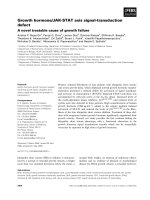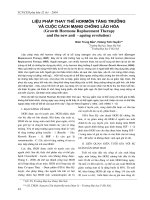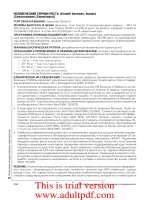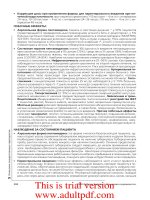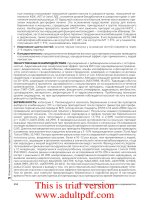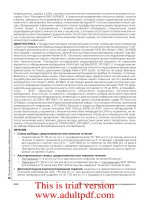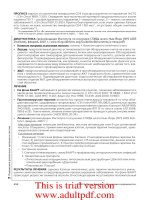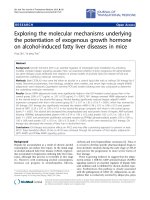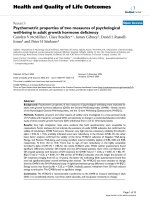34 PEDs growth hormone
Bạn đang xem bản rút gọn của tài liệu. Xem và tải ngay bản đầy đủ của tài liệu tại đây (1.07 MB, 29 trang )
UNIVERSITY
PEDs
Human Growth Hormone
Lesson Overview
What is GH/IGF-1 Role and Mechanism of Action
Regulation of GH/IGF-1 Axis
GH/IGF-1 effect on hypertrophy
Why do we retain fluid on HGH?
Gender Differences in HGH usage and role of estrogen
GH Indirect Actions
AAS and HGH synergy
Is there a ceiling dosage for HGH?
Why Autocrine GH/IGF-1 is Important
How should we time HGH?
What is the effect of HGH on endocrine production?
Does HGH effect Insulin Resistance?
Does HGH effect the Thyroid?
Is there a maximum dosage for fat loss?
Hypertrophy Dosing Recommendations
Fat loss Dosing Recommendations
GH/IGF-1 Main Purpose
How Does it Carry out this Purpose?
GH is priming the body for growth by making energy substrate
available, Growth is energy costly.
How Does it Carry out this Purpose?
IGF-1 is taking the energy substrate made available by GH and using it
for growth and repair. IGF-1 Carries out most growth promoting
aspects.
Regulation of GH/IGF-1 Axis
GH on Hypertrophy
Numerous trials of exogenous GH administration in healthy subjects
show no change in muscle protein synthesis or direct hypertrophy
outcomes
“Effect of growth hormone and resistance exercise on muscle growth
in young men”( Yarasheski 1992)
Eighteen 21-34-year-old men, 12-week resistance training, 1.5g/kg
protein /day; one group placebo, one group GH 0.04mg/kg 5 days per
week post workout. Plasma insulin and glucose not effected by GH.
After 5 days treatment water drop. Serum GH peaked 2.5hrs post
injection
“The combination of resistance training and GH administration is no
more effective in increasing muscle size and strength and the rate of
muscle protein synthesis than resistance training without GH.”
Why the Water Retention?
”Effects of growth hormone on renal
tubular handling of sodium in healthy
humans” (Hansen 2001)
6 day trial, 6IU GH vs control vs GH
+400mg Ibuprofen per day
GH Indirect Effects on Muscle Growth
• Potent stimulator of collagen synthesis in tendons and skeletal
muscle, via autocrine IGF-1 mediated fibroblast stimulation. Positive
application in athlete longevity.
• Increased decorin gene expression. Decorin is protein in skeletal
muscle main role is growth and repair.
• Cell cultures demonstrate GH promote satellite cell proliferation and
differentiation into myofibers and provide increase myonuclei. Again,
not demonstrated in humans.
• AAS increase satellite cell numbers, providing more raw material for
GH to take action on, this is key.
So, GH alone has minimal impact on hypertrophy does combined AAS
usage change this?
AAS + GH Synergy
“Growth Hormone and Sex Steroid Administration in Healthy Aged
Women and Men”( Blackman 2002)
26 week Trial
57 women and 74 men 65-88 yrs old
Men: 0.03-0.02mg/kg GH 3x per week + test E 200mg/wk
Women: 0.03-0.02mg/kg GH 3x per week + estradiol 100mcg/d +
medroxyprogesterone acetate 10mg/day PO.
Continue normal activity
AAS + GH+ Insulin Synergy
AAS effects:
Testosterone alone increase GH/IGF-1 expression, while non/low aromatizing androgens
causing much less of an impact. (nandrolone/trenbolone)
AI and SERM usage attenuate the effects of testosterone on GH/IGF-1, AI is less impactful on
GH hepatic action than a SERM.
Increased GH receptor expression in skeletal muscle
Increased local IGF-1 mRNA expression in skeletal muscle
Nearly 95% of all circulating IGF-1 exists in a bound state (most bound to IGFBP-3, 6 other
isoforms). Binding proteins increase bioavailability, extend serum life. Can inhibit or enhance
IGF action. AAS Decreased IGFBP-4 in local muscle, increase IGFBP-3 systemically.
GH effects:
GH and AAS enhance collagen synthesis
GH stimulated JAK/STAT5 pathway direct relationship with local IGF-1, this pathway is also
downstream target for androgen receptor gene expression. So, GH increase AR expression
(GH makes your current AAS more effective).
Insulin effects:
Insulin increases GHR, reverses IGF-1 desensitization, stimulates GH to IGF-1 expression.
AAS + GH+ Insulin Synergy
Figure 1. Mechanisms of action of GH, IGF-1, and insulin in skeletal muscle AAT, amino
acid transporter. Intramuscular anabolic mechanisms mediated by GH, IGF-1, and insulin
providing the theoretical basis for use of these agents as PEDs. (Anderson, 2017)
Ceiling Dosage for Systemic IGF-1
• Saturation point of GH/IGF-1 within 4-7 days (Tanaka 1999)
• Individual response to varying dosing patterns
• Advice don’t use more than needed to reach a peak level
Localized (Autocrine) GH to IGF-1
What we want is more localized IGF-1, not systemic.
There is a celling dose for localized IGF-1 expression within the muscle.
In human muscle studies, GH to IGF-1 mRNA expression occurs within 30-60min and
peaks within 1-2 hours and last for 48hours. (Frost et al)
The maximal dosage to stimulate mRNA expression was a dose between 7.5ng/mL
and 30ng/mL, which is similar to levels seen in endogenous secretion post training.
Local administration in animal models as shown increased local IGF-1 and localized
growth with or without resistance exercise. Even GH compared to IGF-1 injection.
IGF-1 injection likely less effective without binding proteins (IGF LR3, DES, etc)
Systemic IGF-1 works as a negative feedback for localized autocrine production of
IGF-1
TAKE HOME POINT: Local IGF-1 is far more important for hypertrophy than systemic
IGF-1 levels
Localized (Autocrine) IGF-1 Levels
Only pulsatile GH administration, and not continuous infusion, can
maximally stimulate IGF-1 mRNA expression in skeletal muscle (Frost)
Pulsatile administration may also lead to comparable, or even
decreased, serum systemic IGF-1 levels (Bick)
For hypertrophy, peaking GH and getting it back to a baseline level
with multiple injections seems ideal.
There is also a desensitized refractory period within the JAK/STAT5 for
~5hours post GH administration where further administration does
not cause same IGF-1 Response (Frost)
Insulin can resensitize the JAK/STAT5 pathway to GH. A meal between
GH administration with an insulin increase would accomplish this.
GH Timing
Three 4-week study periods in random order receiving 1) daily sc
injections of 2 IU GH given in the evening (at 2000 h), 2) daily sc
injections of 2 IU GH given in the morning (at 0800 h), or 3) no GH.
(Jorgensen)
GH in daytime gave higher serum glucose and insulin levels, while PM
administration normalized carbohydrate and lipid metabolism.
GH bioavailability was further enhanced in PM administration
GH and Endocrine GH Suppression
18-month trial HIV
patient's GH withdrawal
effects. ~0.018IU/kg/day
(Lo 2010)
Single administration of
2IU GH and serum GH
levels 6 hours later at
onset of sleep.
(Mendelson 1983)
GH and Insulin Resistance
“Effects of Growth Hormone on Glucose Metabolism and Insulin
Resistance In Human” (Kim 2017) review paper.
High dose GH usage >0.01mg/kg/day increase fasting glucose and
insulin levels and increased insulin resistance, A1c remained relatively
unchanged.
Low dose GH usage <0.01mg/kg/day show transient changes in fasting
glucose levels and unchanged insulin resistance after long term usage.
GH increases glucose production from liver and decrease uptake in
peripheral tissue, FFA increase from adipose tissue, causes high serum
glucose and FFA. IGF-1 has opposing effects. A genetic disposition to
diabetes my be induced by GH therapy.
GH and Thyroid Axis
GH increase T4 to T3
conversion in peripheral
tissue, lowering T4 and
reverse T3.
This effect is transient and
stabilize with continued
administration in healthy
individuals
In GH deficiency with
hypopituitary patients, GH
therapy can bring about
an underling thyroid
conditions. (Behan)
In hyperthroidsim,
increased GH urinary
clearance, low GHR
binding affinity, suppressd
GH/IGF-1 synthesis.
(Laron)
HGH and Gender Differences
Females are less responsive to HGH to IGF-1 conversion compared to males.
To achieve similar IGF-1 levels to males higher dosages of HGH are needed.
In both men and women, local estrogens derived from the aromatization of androgens stimulate GH
secretion in the hypothalamus. Hence TRT therapy combined with Aromatase Inhibitors (AI) limits
endocrine GH secretion.
Oral estrogens shown to decrease GH to IGF-1 expression in liver and increase IGFBP-1 reducing
bioactive IGF-1.
Males treated with testosterone have an enhanced GH to IGF-1 expression and increase GH receptor
expression
Selective Estrogen Receptor Agonist (SERM) has dual effect lowering GH and IGF1 via decreased
liver IGF-1 expression and estrogen receptor antagonism at the hypothalamus.
Males treated with testosterone have an enhanced GH to IGF-1 expression and increase GH receptor
expression
Both GH and testosterone are required to exert full anabolic effects.
With Exogenous HGH pituitary production is not an issue, so if estrogen control is needed an AI is
the better option over a SERM.
Note: limit oral estrogen-based birth control, use non oral route or IUD.
Estrogen and Estrogen Antagonist GH Effects
Figure: Birzniece 2017
GH Hypertrophy Recommendations
1.
Combined Stack of AAS and GH for females or males (GH alone
minimal effect)
2. Females non hormone-based birth control is ideal
3. AAS should have a testosterone base for estrogen positive role on
GH/IGF-1 axis
4. FDA Pharm grade or validated generics with HPLC testing
5. Ceiling dosage around 4-8IU per day, monitor serum IFG-1 for peak
levels obtained.
6. Administer in pulses during day close to physiological norm, ~2IU per
administration.
7. Timing of injections less important as IGF-1 is elevated for days, I
would time around normal physiological peaks (Pre bed >post
training>Am>pre training)
8. Have a carbohydrate-based meal between dosing for GH/IGF-1 axis
resensitization
9. Limit AI, SERM, and thyroid hormone usage
10. Local IM injections can be considered for lagging body parts
11. There is no need for cycling on and off, lowering GH to physiological
norm (2-3IU) during cruise periods would be advised for decreased
systemic stress and restoring insulin sensitivity.
12. Add to anabolic stack early within career to maximize all hypertrophy
pathways and enhance current AAS usage, minimal 2IU as starting
point.
Sample GH Layout
Meal 1
1- hour pre meal 1.5-2.0 GH with meal
Meal 2
Meal 3
Train
Immediate post training 1.5-2.0 GH
Meal 4 (post meal)
Meal 5
Meal 6
1.5-2IU pre bedtime
GH and Fat loss
GH Maximum Rate of Lipolysis?
Dose-dependent increase in FFA mobilization from no rHGH to
0.001mg/kg to 0.003mg/kg, no further increase with 0.006mg/kg. This
would be close to 1.2-1.5IU/100kg. GH administered via IV. (Hansen
2002).
FFA mobilization peak around 150-160min mark
Fat Loss Synergies
GH increase hormone sensitive lipase, decreases lipoprotein lipase,
increased catecholamine sensitivity.
AAS increase beta adrenergic receptor expression and direct action on
the beta receptors
Ensure optimal thyroid levels for metabolic rate and beta receptor
expression
Utilizing a beta-adrenergic receptor agonist like clenbuterol would
maximize fat mobilization ability
